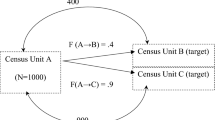Abstract
This article presents some findings on neighborhood structure, police recorded crime, and offender mobility for the city of Utrecht, the Netherlands. The highest crime rates were found in the inner-city neighborhoods. The findings further show that the occurrence of different types of petty crime in residential neighborhoods is associated with different neighborhood characteristics. It was found that offenders reside predominantly in lower-social status neighborhoods. Using data on offender mobility it is shown that violent crime and vandalism are the more locally committed crimes, as compared to residential burglary and other property crime. Finally, it is proposed that data on offender mobility can be used to gain more insight into the link between certain neighborhood characteristics and crime.
Similar content being viewed by others
References
Boelhouwer, P. J., and Dieleman, F. M. (1986).Wonen in de Stad; Samenvatting van sociaalgeografisch onderzoek in de Domstad, Amsterdam.
Boggs, S. L. (1965). Urban crime patterns.Am. Sociol. Rev. 30: 899–908.
Bottomley, K., and Coleman, C. (1981).Understanding Crime Rates, Gower, Westmead.
Bottoms, A. E., Mawby, R. I., and Walker, M. A. (1987). A localised crime survey in contrasting areas of a city.Br. J. Criminol. 27: 125–154.
Byrne, J. M., and Sampson, R. J. (1986). Key issues in the social ecology of crime. In Byrne, M., and Sampson, R. J. (eds.),The Social Ecology of Crime, Springer-Verlag, New York, pp. 1–22.
Clarke, R. V. (1984). Opportunity-based crime rates.Br. J. Criminol. 24: 74–83.
Cohen, L. E., and Felson, M. (1979). Social change and crime rate trends: A routine activity approach.Am. Sociol. Rev. 44: 588–608.
Cohen, L. E., Kluegel, J. R., and Land, K. C. (1981). Social inequality and predatory criminal victimization: An exposition and test of a formal theory.Am. Sociol. Rev. 46: 505–524.
Cornish, D. B., and Clarke, R. V. (1986). Introduction. In Cornish, D. B., and Clarke, R. V. (eds.),The Reasoning Criminal, Springer-Verlag, New York, pp. 1–16.
Crutchfield, R. D., Geerken, M. R., and Gove, W. R. (1982). Crime rate and social integration.Criminology 20: 467–478.
Dillon, W. R., and Goldstein, M. (1984).Multivariate Analysis, Methods and Applications, John Wiley & Sons, New York.
Dunn, C. S. (1980). Crime area research. In Georges-Abeyie, D. E., and Harries, K. D. (eds.),Crime, A Spatial Perspective, Columbia University Press, New York, pp. 5–25.
Dunteman, G. H., (1989).Principal Components Analysis, Sage Publications, Newbury Park.
Engstadt, P. A. (1975). Environmental opportunities and the ecology of crime. In Silverman, R. A., and Teevan, J. J., Jr. (eds.).Crime in Canadian Society, Butterworth, Toronto, pp. 193–211.
Figlio, R. M., Hakim, S., and Rengert, G. F. (1986).Metropolitan Crime Patterns, Willow Tree Press, New York.
Fiselier, J. P. S. (1979).Kriminaliteit in Nijmegen, een kriminografie van de gemeente Nijmegen, Katholieke Universiteit Nijmegen, Nijmegen.
Gabor, T., and Gottheil, E. (1984). Offender characteristics and spatial mobility: An empirical study and some policy implications.Can. J. Criminol. 26: 267–281.
Greenberg, S. W., Rohe, W. M., and Williams, J. R. (1985).Informal Citizen Action and Crime Prevention at the Neighborhood Level, U.S. Department of Justice, Washington, D.C.
Hesseling, R. B. P. (1986).Kleine Criminaliteit in Utrecht, A Case Study, Staatsuitgeverij, 's-Gravenhage.
Junger-Tas, J., and Kruissink, M. (1990).Ontwikkeling van de Jeugdcriminaliteit:periode 1980–1988, Gouda Quint bv, Arnhem.
Kennedy, D. B. (1980). Facility site selection and analysis through environmental criminology.J. Crim. Just. 18: 239–252.
Lenz, R. (1986). Geographical and temporal changes among robberies in Milwaukee. In Figlio, R. M., Hakim, S., and Rengert, G. F. (eds.),Metropolitan Crime Patterns, Willow Tree Press, New York, pp. 97–115.
Massey, J. L., Krohn, M. D., and Bonati, L. M. (1989). Property crime and the routine activities of individuals.J. Res. Crime Delinq. 26: 378–400.
McIver, J. P. (1981). Criminal mobility: a review of empirical studies. In Hakim, S., and Rengert, G. F. (eds.),Crime Spillover, Sage, Beverly Hills, Calif., pp. 20–47.
Newman, O. (1973).Architectural Design for Crime Prevention, U.S. Department of Justice, Washington, D.C.
Phillips, P. D. (1980). Characteristics and typology of the journey to crime. In Georges-Abeyie, D. E., and Harries, K. D. (eds.),Crime, a Spatial Perspective, Columbia University Press, New York, pp. 167–180.
Reppetto, A. (1974).Residential Crime, Ballinger, Cambridge, Mass.
Sampson, R. J. (1983). Structural density and criminal victimization.Criminology 21: 276–293.
Sampson, R. J. (1985). Neighborhood and crime: The structural determinants of personal victimization.J. Res. Crim. Delinq. 22: 7–40.
Sampson, R. J. (1986). Neighborhood family structure and the risk of personal victimization. In Byrne, M., and Sampson, R. J. (eds.),The Social Ecology of Crime, Springer-Verlag, New York, pp. 25–46.
Shaw, R. C., and McKay, H. D. (1969).Juvenile Delinquency and Urban Areas, University of Chicago Press, Chicago.
Skogan, W. G. (1975). Measurement problems in official and survey crime rates.J. Crim. Just. 3: 17–32.
Sparks, R. F. (1980). Criminal oppportunities and crime rates. In Fienberg, S. E., and Reiss, A. J., Jr. (eds.),Indicators of Crime and Criminal Justice: Quantitative Studies, U.S. Department of Justice, Washington, D.C.
Smith, D. A., and Jarjoura, G. R. (1989). Household characteristics, neighborhood composition and victimization risk.Soc. Forces 68: 621–640.
Stahura, J. M., and Sloan, J. J., III (1988). Urban stratification of places, routine activities and suburban crime rates.Soc. Forces 67: 1102–1118.
Taylor, R. B., and Gottfredson, S. (1986). Environmental design, crime, and prevention: An examination of community dynamics. In Reiss, Jr., and Tonry, M. (eds.),Communities and Crime, University of Chicago Press, Chicago, pp. 387–416.
Taylor, R. B., Gottfredson, S. D., and Brower, S. (1980). The defensibility of defensible space: A critical review and a synthetic framework for future research. In Hirschi, T., and Gottfredson, M. (eds.),Understanding Crime, Current Theory and Research, Sage, Beverly Hills, Calif., pp. 53–71.
Wikström, P. H., and Dolmén, L. (1990). Crime and crime trends in different urban environments.J. Quant. Criminol. 6: 7–28.
Author information
Authors and Affiliations
Rights and permissions
About this article
Cite this article
Hesseling, R.B.P. Using data on offender mobility in ecological research. J Quant Criminol 8, 95–112 (1992). https://doi.org/10.1007/BF01062761
Issue Date:
DOI: https://doi.org/10.1007/BF01062761




